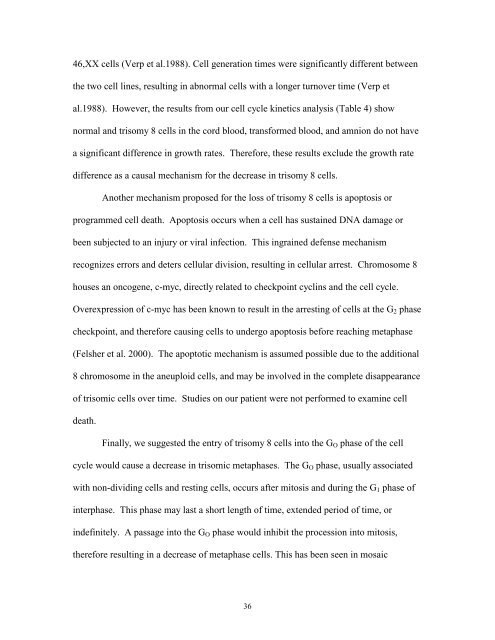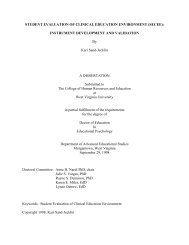TRISOMY 8 MOSAICISM: CELL CYCLE KINETICS AND ...
TRISOMY 8 MOSAICISM: CELL CYCLE KINETICS AND ...
TRISOMY 8 MOSAICISM: CELL CYCLE KINETICS AND ...
You also want an ePaper? Increase the reach of your titles
YUMPU automatically turns print PDFs into web optimized ePapers that Google loves.
46,XX cells (Verp et al.1988). Cell generation times were significantly different between<br />
the two cell lines, resulting in abnormal cells with a longer turnover time (Verp et<br />
al.1988). However, the results from our cell cycle kinetics analysis (Table 4) show<br />
normal and trisomy 8 cells in the cord blood, transformed blood, and amnion do not have<br />
a significant difference in growth rates. Therefore, these results exclude the growth rate<br />
difference as a causal mechanism for the decrease in trisomy 8 cells.<br />
Another mechanism proposed for the loss of trisomy 8 cells is apoptosis or<br />
programmed cell death. Apoptosis occurs when a cell has sustained DNA damage or<br />
been subjected to an injury or viral infection. This ingrained defense mechanism<br />
recognizes errors and deters cellular division, resulting in cellular arrest. Chromosome 8<br />
houses an oncogene, c-myc, directly related to checkpoint cyclins and the cell cycle.<br />
Overexpression of c-myc has been known to result in the arresting of cells at the G2 phase<br />
checkpoint, and therefore causing cells to undergo apoptosis before reaching metaphase<br />
(Felsher et al. 2000). The apoptotic mechanism is assumed possible due to the additional<br />
8 chromosome in the aneuploid cells, and may be involved in the complete disappearance<br />
of trisomic cells over time. Studies on our patient were not performed to examine cell<br />
death.<br />
Finally, we suggested the entry of trisomy 8 cells into the GO phase of the cell<br />
cycle would cause a decrease in trisomic metaphases. The GO phase, usually associated<br />
with non-dividing cells and resting cells, occurs after mitosis and during the G1 phase of<br />
interphase. This phase may last a short length of time, extended period of time, or<br />
indefinitely. A passage into the GO phase would inhibit the procession into mitosis,<br />
therefore resulting in a decrease of metaphase cells. This has been seen in mosaic<br />
36












